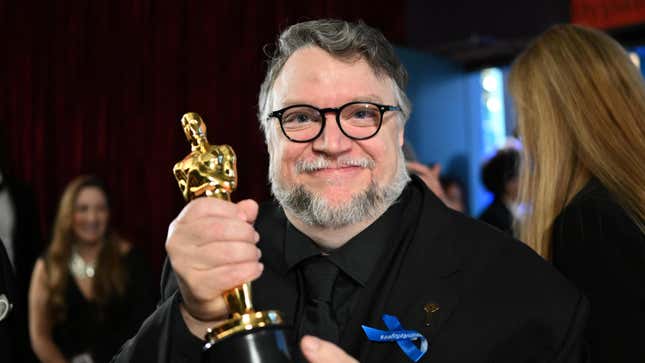
At last night’s Academy Awards, Guillermo del Toro took home the first award of the evening for his stop-motion animation adaptation of Pinocchio. The director has been a leader in the conversation around the role of animation in Hollywood over the last year, and his win marks a major win for the medium seeking to step out of the confines of genre.
“Animation is cinema, animation is not a genre, and animation is ready to be taken to the next step,” del Toro said in his acceptance speech. “Keep animation in the conversation.”
“It’s good to know that this art form that we love so much, stop-motion, is very much alive and well,” added Pinocchio co-director Mark Gustafson.
If this sounds like a familiar refrain, it is. Last night was far from the first time del Toro has defined animation as cinema, looking to defy expectations as a medium for young audiences and lack of prestige among its filmmaking peers.
“This is an art form that has kept being kneecapped commercially and industrially and [kept at] the kid’s table for so long,” del Toro told The Hollywood Reporter backstage. “And it really is a mature, expressive, beautiful, complex, art form. So a win helps, but it is about going forward as a community.”
He added that he plans on taking the conversation on animation to the Guilds and the Academy. He told THR he will “push this message” at the upcoming Annecy International Animation Festival.
“It’s important that we keep this alive as an industry and an art form,” del Toro said. “I have right now two scholarships active for filmmakers, and it is my desire and my commitment now to finance a stop-motion class [in Mexico].”
He continues, “It will help us give more movies in the community in Mexico and in Latin America, to keep pushing for stop motion, which is one of the most democratic forms of animation. All the other forms of animation are too difficult or too expensive. But a kid can put a camera on the wall in their room, they can do animation in stop motion.”
Over the last year, animators across the industry have assessed the state of animation, pushing back on the infantilization of the art form, as well as its lack of consideration by the Academy for categories such as Best Picture. In recent interviews with Vulture, prominent animators discuss how the Academy reinforces the divide between animation and live-action film.
“The word that me and a lot of my colleagues use is ghettoization,” says Kirk Wise, director of Beauty And The Beast (1991). “There were those in the awards broadcast who had to be snarky and pooh-poohed the notion of a ‘cartoon’ being included with ‘real movies.’”
Animators have decried Disney’s chokehold on the form and domination of the Best Animated Feature category, as well as its general exploitation for capitalistic gains and presentation of the medium as predominantly for children.
“Your only question is, ‘Am I going to get to lose to Disney this year?’” adds Craig Staggs, co-founder of indie studio Minnow Mountain. “Disney wins, and nobody pays attention to your film. And Disney was going to get the attention anyway.”
Del Toro’s Pinocchio managed to beat out Disney in the Best Animated Feature category, becoming the second non-Disney film to win in the last decade, and the second stop-motion film to win after 2005's Wallace & Gromit: The Curse Of The Were-Rabbit. Its win is a triumph in numerous ways, as del Toro’s work on this film highlights the skill, attention to detail, and hours and hours needed to craft a work of this caliber. Although Pinocchio was del Toro’s first animated endeavor, hopefully, it will not be his last and he continues to propel the conversation around animation.